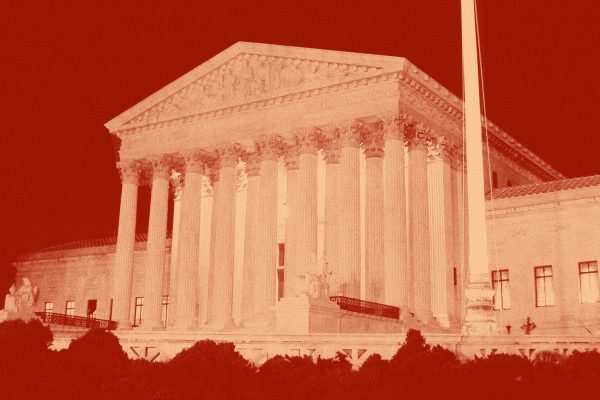The Alchemy of Race and Rights: Diary of a Law Professor
Patricia J. Williams
Harvard University Press, $10.95
In this extraordinary work by black legal scholar Patricia Williams, even the index is art. Here is a passage from the d’s: “dancing, Dartmouth College, death, death rate — black, Deep Throat, default judgements, discourse, disenfranchisement, disutility of rights, dogs, dreams, Dred Scott.” From the f’s: “Farrakhan, FEMA, feminism, fetus, first amendment, fish, floating signifiers, food stamps, football player (weeping).” And my favorite, the l’s: “L.L. Bean, Jacques Lacan, Jessica Lange, Law and Society Association, King Lear.”
This index tells us much about Patricia Williams: her appreciation of the politics of words and classifications, her recognition of the subversive power of strategic category mistakes, her abiding commitment to making visible lives and experiences erased by abstract legal language, but especially her appreciation of the medieval practice of alchemy. With the alchemists’ conviction that something of great value can be concocted out of rough and diverse elements, she conjures an account of racial subordination from anecdote, history, literary theory, and philosophy, The New York Times, legal cases, the sustained working of metaphor and fairy tales, family history, classroom experiences, slow motion snapshots of street life, and a mélange of the frustration, humor, arrogance, indignation, self-doubt, sublimated rage, irony, and isolation comprising the experience of many professionals from historically excluded and currently marginalized groups.
As a meditation on the searing injuries of racism, on hidden histories in the entrails of legal cases, or on the bankrupt character of contemporary American political life, the effect of Williams’s alchemy is powerful beyond measure. Still, the argument expressed in the book’s title — about the special alchemy of race and rights– gives pause, especially in view of the condition of black America 30 years after the Civil Rights movement. And here we might recall that alchemy is more than “little bits of law and pieces of everyday life fly[ing] out of [one’s] mouth in weird combinations.” Medieval alchemists sought to make gold from copper or lead and for this process required magical powers of transmutation. Because their efforts met with limited success, alchemy also came to connote counterfeit — those metallic compositions like brass which imitated gold. So alchemy is not only about imaginative juxtapositions, anti-literalism, and insurrectionary skepticism about the language of the powerful; it is also about dreams of monetary riches, magic, fool’s gold, and failure.
What, then, if we consider the illusory, commercial, and counterfeit promises offered by an “alchemy of race and rights?” Such consideration requires discerning when magic might function as an immeasurably powerful medium of hope that leads, against all odds, to staking a claim in the world, and when it is otherworldly religion — Christ’s second coming or a winning lottery number. It requires considering, too, whether rights are like metals — something one holds in the hand and handles instrumentally — or whether they are more like institutions — subtly configuring cultures and individuals in their image and converging with other, inegalitarian forms of social power. And it requires discerning whether rights are really so plastic — so much a matter of words — that we can, as Williams proposes, “expand private property rights into…the right to expect civility from others” or turn a right to privacy “into regard for another’s fragile, mysterious autonomy.”
Williams (in whose analysis of the law, “subject position is everything”) analyzes rights from the perspective of people — especially African-Americans — who have historically been denied them in a culture where political membership, bodily and sexual boundary, social respect, privacy, and visibility are all negotiated through the language of rights and rightlessness. If the importance of this perspective cannot be overstated, neither can its partiality. For deprivation on this scale is not merely lack but the formation of desire through this lack. Homosexuals may idealize the legitimacy conferred by the institution of marriage from which we are debarred, and in this way idealize what is premised upon our exclusion. Similarly, I worry about Patricia Williams’s defense of rights as “a symbol too deeply enmeshed in the psyche of the oppressed to lose without trauma and much resistance” (165). This deeply enmeshed symbol — by converting the workings of non-legal power into self-reproach and depoliticized suffering — may operate not only for but against that psyche. In the end, then, Williams’s dazzling critique of late 20th century cultural and political life in the United States may be severely compromised, even made incoherent, by her refusal to subject rights and their relationship to the inequalities and corruptions of capitalism, to her scorching gaze.
Rights and Privacy
For Patricia Williams, the “over-expanded mental state we call `privacy'” is among the most pernicious and subtle contemporary enemies of substantive democracy, as well as a powerful mode of justifying class and race inequalities. “The tyranny of what we call the private,” she argues, risks reducing us to “the life crushing disenfranchisement of an entirely owned world where permission must be sought to walk on the face of the earth” (43). Williams sees the corrosive effects of privatization in contemporary arguments about “reverse discrimination” and for “employer preference,” in Supreme Court decisions permitting states to determine levels of indigent support, in police commissioner complaints about being singled out for media attention during police brutality investigations, in John Tower’s promise to give up drinking if confirmed as George Bush’s defense secretary. She criticizes both the privatization of public functions by the economy — workfare or school vouchers — and the privatization of the economy itself. The latter frames an incident in which a young white Benetton salesman refused her entry to a buzzer-controlled shop in New York as well as a sign in a Greenwich Village boutique — “Sale! $2 overcoats. No bums, no booze” — which commodifies poverty while excluding the poor (42). Williams also traces forms of privatization that, like the design of corporate parks and shopping malls, effectively resegregate populations along lines of race and class. Reflecting on Mayor Koch’s plea for black compassion toward white Howard Beach residents unhappy about an interracial protest march through “`their’ streets,” she writes:
Koch was, in effect, pleading for acceptance of the privatization of public space. This is the de facto equivalent of segregation; it is exclusion in the guise of deep-moated property “interests” and “values.” Lost is the fact that the object of discussion, the street, is public. (69)
Williams examines the way the language of privacy and its cousin, “choice,” are used to disguise state coercion as private desire. When defendants in child abuse or rape cases are “offered a `choice’ between…jail and sterilization…the defendant is positioned as a purchaser, as `buying’ her freedom by paying the price of her womb” or by “choosing castration” (32). This repackaging of state domination as market freedom, she argues, imperils both public morality and the meaning of citizenship. It vandalizes a language of public obligation and at the same time legitimizes the de facto racism, misogyny, and hatred of the poor that, in her analysis, it is the task of politics to mitigate.
But how can Williams reconcile this compelling political critique of privatization with her unalloyed defense of rights? Rights, after all, are those bits of political discourse which quintessentially privatize and depoliticize; they cast such social powers as property and wealth — and even race, sexuality, and gender — as the natural endowments of human beings. By abstracting us from social and political context, by masking the powers which construct, stratify, and injure us, rights discourse casts us as self-made (or self-unmade) individuals formally equal before the law. What could be a more enduring, pervasive, and legitimate form of privatization? As the Reagan-Bush years made clear, the language of individual rights is precisely what furnishes the claims of reverse discrimination and employer preference, the justifications for school voucher systems and regressive tax reform, the prerogatives of store owners and of neighborhoods to restrict access. What does rights discourse do to politics, if not convert social problems into matters of individual injury and entitlement, into matters in which there is no harm if there is no tangible agent and no tangibly violated subject? What more thoroughly obscures domination by regulatory norms — the “whiteness” or “maleness” of certain standards of excellence — than the image of the sovereign subject of rights? What more fiercely undercuts public obligation and common commitments, the spirit of service professions and the kindness of strangers, than the contemporary proliferation of individual rights claims?
None of this is to suggest that those without rights in a rights-governed universe should abandon the struggle to acquire and use them. Such counsel, especially from white, upper middle class academics, is strategically naive and disavows its cultural positioning. But an argument for the importance of having rights where rights are already currency is not yet an assessment of the political culture they create. Rather, that argument highlights the foolishness of walking into a pitched battle unarmed and the crippling force of being deemed unworthy of whatever a given culture uses to designate humanity. The question Williams’s defense leaves unasked is whether the proliferation of rights she advocates might not abet the phenomenon she calls privatization, the encroachment of “a completely owned earth,” the disintegration of public obligations and a political culture of common responsibility. It also leaves unexamined the relationship between “the promise of rights for black people” as “an illusion [that] became real for only a few…” and the function of rights in depoliticizing economic power, in privatizing economic circumstances — in short, in disguising class divisions.
Rights, Desires, and Public Exposure
Williams’s defense of rights veers away from the question of class and focuses instead on the historical deprivation of social, sexual, and physical integrity that rightlessness implied for blacks in the United States. “[W]here one’s experience is rooted not just in a sense of illegitimacy but in being illegitimate…then the black adherence to a scheme of…rights — to the self, to the sanctity of one’s own personal boundaries — makes sense” (154). If, she argues, rights function to individuate, separate, and defend individuals, to define a sphere of bodily integrity and privacy, and to establish membership in a political community, they may be exactly what is needed by the historically disenfranchised and dehumanized. Moreover, given the often violent “familiarity” and “informality” with which whites have treated blacks in the United States, a little distance, abstraction, and formal rather than substantive or intimate recognition might be just the thing. “For me,” Williams argues, “stranger-stranger relations are better than stranger-chattel” (148).
Elaborating this argument, Williams describes the dilemma of “exposure or hiding” as both the constant experience and the measure of subjugation of black women. The choice between humiliating exposure or desperate hiding is the non-choice which configures the drama of Tawana Brawley, Anita Hill, black women as professionals, black women as slaves (“teeth and buttocks bared to interested visitors”), black women’s contemporary positioning in a racial-sexual economy which routinely marks black female sexuality as unbarred availability. Williams studies the endlessly reproduced picture of Tawana Brawley arriving at the hospital: “Her body so open and public; her eyes closed, her face shuttered, her head turned always away from the cameras” — exposure and hiding at once (177). Williams’s own “exaggerated visibility and invisibility” as a black female law professor is another reminder that even the choice between exposure and hiding is often unavailable, that both can occur simultaneously — as in the apparent oxymoron of “exaggerated invisibility.”
The conditions that impose this unnavigable “choice” between exposure and hiding clearly call for redress through social practices which accord black women autonomy, agency, and privacy. But perhaps this violent legacy also takes shape as a complex form of desire in the subjects it creates, a desire figured in Patricia Williams’s deeply personal writing. Indeed, how else to explain her production of our intrusion into her morning toilette — her exposure of how with astringent, mascara and lip glaze she “hangs her face, in contradictions” to “deny pain…be a role model…pave the way for her race” — and in this way restages the scene of invasion, the absence of bodily privacy that is the history of African-American women? How else to explain the revelation of bouts of depression, humiliating teaching evaluations, unedited dreams and nightmares, long hours of suffering in her terry cloth bathrobe and vanity before the mirror? Perhaps it is this historically produced desire– for the right to expose oneself without injury, and for the right to hide without recrimination– that undergirds a certain desire for rights, those implements which promise to guard exposed subjects and legitimize hiding. But rights could only fulfill this promise if they could make visible the effects of complexly internalized histories of violation and degradation. This visibility is precisely what they thwart in figuring desire as something natural, intrinsic, and unhistorical.
Thus, it may be that the condition which marks one as a cultural “other” — being condemned to exposure or hiding, being spectacle or being invisible (here homosexuality also comes to mind) — is as much intensified as redressed by rights: the same device which confers boundary, privacy, and generic personhood leaves the individual to struggle alone, and in a self-blaming and depoliticized universe, with power that seeps past right and with desire configured by power prior to right. It may be that the discourse of rights, Judge Maxine Thomas’s stock in trade, is exactly what could not protect her from, and indeed what stole the political language for, the unlivable contradictions which finally made this stunningly accomplished black female judge “split at the seams and return to the womb…exploded into fragments of intelligence and scattered wisdom” (196-7). It may be that the withdrawal that rights permit, and the destigmatizing they promise, has a serious cost — the loss of a language to describe the character of domination, violation, or exploitation that fashion such needs in the first place. What if the desire for withdrawal into the buffered and enclosed space of liberal personhood marked by rights is symptom, and what if treating the symptom covers over its generative source? What if, as Marx put it, the “right of the circumscribed individual, withdrawn into himself” responds to the socially produced condition of exposure or hiding, unbearable vulnerability or invisibility, humiliation or death, by codifying that condition as natural and installing it in the law?
Rights and Realism
Yet another strand in Williams’s defense of rights is, in the broadest sense, political. As the historically and currently existing social form of freedom, rights are both concretely available and “magic in the mouths of black people.” Yet, even as Williams insists upon the intelligibility and immediate political efficacy of rights and contrasts this efficacy with the “timeless, formless futurism” held out by rights critics, she also argues for the exploitability of the “indeterminacy of rights,” the possibility that they can be turned in radical new directions. Indeed, the final portion of Williams’s defense of rights is framed in a powerful argument from political efficacy and political alchemy:
To say that blacks never fully believed in rights is true. Yet it is also true that blacks believed in them so much and so hard that we gave them life where there was none before; we held onto them, put the hope of them into our wombs, mothered them and not the notion of them….The making of something out of nothing took immense alchemical fire — the fusion of a whole nation and the kindling of several generations. The illusion became real for only a few of us; it is still elusive for most. But if it took this long to breathe life into a form whose shape had already been forged by society….imagine how long the struggle would be without even that sense of definition, without the power of that familiar vision. What hope would there be if the assignment were to pour hope into a timeless, formless futurism? (164)
Despite the air of pragmatism suggested in her final question, Williams’s impassioned conclusion to this chapter calls for so dramatic a project of resignifying rights that “timeless, formless futurism” seems an understatement. Here, the “magic of rights in the mouths of black people” is drawn as a capacity for alchemical transmutation that simply defies the historical, political, and economic parameters within which those rights operate. Listen:
The task…is not to discard rights but to see through them or past them so that they reflect a larger definition of privacy and property: so that privacy is turned from exclusion based on self-regard into regard for another’s fragile, mysterious autonomy; and so that property regains its ancient connotation of being a reflection of the universal self. The task is to expand private property rights into a conception of civil rights, into the right to expect civility from others…Society must give rights away…to slaves…to trees…to cows…to history…to rivers and rocks…. (164-165)
My worry here is that appreciation of both the power and the flexibility of the word afforded by recent literary theory may have converged with a certain liberal idealism to exaggerate a sense of what it is possible to do with words. Taking the promise of rights literally on one hand, lifting them from their historical and social context on the other, Williams not only intensifies the idealist tendencies in liberal thought but fails her own powerful critique of the corruptions and violations wrought by capitalism. How could extending “to all of society’s objects and untouchables the rights of privacy, integrity and self-assertion” contest the steady commodification of the earth and of public life that Williams decries? Might words be more mutable, more subject to alchemical fire, than the political histories which generate rights and the political economies in which they operate?
Perhaps the problem with deploying rights for emancipatory purposes lies less in their indeterminacy or instability than in their proffering of a promise which they never fulfill but to which their aspirants remain in thrall. Indeed, part of the “magic” of rights may inhere in the fact that while they formally mark personhood, they cannot really confer it; while they promise protection from humiliating exposure, they do not deliver it — hence the Benetton incident, which no truckload of rights can ameliorate or redress. If rights promise what historically subjugated people most need– the provision of boundary, of protection from “bodily and spiritual intrusion” (164)–rights may also be one of the cruelest social objects of desire dangled above those who lack them. For the very gesture which draws a circle around the individual and grants her sovereign selfhood, also turns back upon the individual all responsibility for her failures, her poverty, her madness. In this respect, perhaps they not only failed to save Judge Maxine Thomas — perhaps they also intensified her isolated struggle with all the contradictory forces of power and freedom that rights disavow in their occupation of the field of justice. Similarly, if rights are all that separate Williams from her bought-and-sold, raped-and-abused great-great grandmother, they were also the device for demeaning Clarence Thomas’s now infamous sister, the device which permitted him and a good many others to insist that if he could become a Supreme Court Justice, then so could she, and only her laziness, her lack of moral fiber or industriousness, or her corruption by “welfare culture” account for the difference.
Williams’s contrast of the concrete, immediate and available character of rights discourse with the “timeless, formless, futurism,” the “unrealistic…unattainable, or otherworldly” characteristic of other emancipatory political projects may, finally, be a false contrast dependent on a false concreteness. Under the guise of the concrete, immediate, determinate, and intelligible, the promise of rights may be as elusive, as otherworldly, as unattainable, as that of any other political myth. Then the most vexing paradox of the struggle for equality and emancipation might be this: the only thing the disenfranchised need as badly as rights is absolute clearsightedness about power, a clearsightedness that rights discourse invariably inhibits.
Originally published in the June-August 1993 issue of Boston Review






